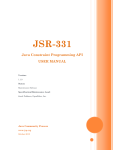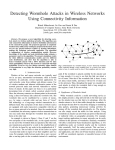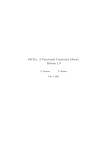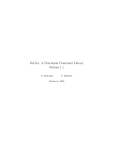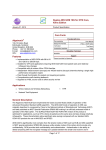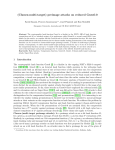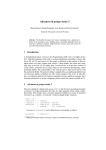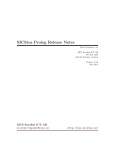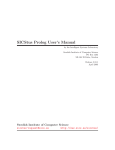Download Rules2CP and PKML User's Manual
Transcript
Rules2CP and PKML User’s Manual
Fran¸cois Fages, Julien Martin
INRIA Paris-Rocquencourt, France
February 5, 2010
2
Contents
1 Getting Started
1.1 Overview . . . . . . . . . . . . . . . . . . . . . . . . . . . . . . . . . . . . .
1.2 Running Rules2CP . . . . . . . . . . . . . . . . . . . . . . . . . . . . . . . .
5
5
6
2 Rules2CP Syntax
7
3 Data structures with their Built-in Functions and Predicates
3.1 Booleans . . . . . . . . . . . . . . . . . . . . . . . . . . . . . . . .
3.2 Integers . . . . . . . . . . . . . . . . . . . . . . . . . . . . . . . .
3.3 Finite Domain Variables . . . . . . . . . . . . . . . . . . . . . . .
3.4 Strings . . . . . . . . . . . . . . . . . . . . . . . . . . . . . . . . .
3.5 Lists . . . . . . . . . . . . . . . . . . . . . . . . . . . . . . . . . .
3.6 Records . . . . . . . . . . . . . . . . . . . . . . . . . . . . . . . .
.
.
.
.
.
.
9
9
9
9
12
12
13
4 User-defined Functions and Predicates
4.1 Functions defined by Declarations . . . . . . . . . . . . . . . . . . . . . . . .
4.2 Predicates defined by Rules . . . . . . . . . . . . . . . . . . . . . . . . . . .
15
15
15
5 Combinators
5.1 Let . . . . . . .
5.2 Map . . . . . .
5.3 Forall, Exists .
5.4 Fold right, Fold
.
.
.
.
17
17
17
17
18
6 Search
6.1 Enumeration of Variables . . . . . . . . . . . . . . . . . . . . . . . . . . . .
6.2 And/Or Search Trees . . . . . . . . . . . . . . . . . . . . . . . . . . . . . . .
6.3 Optimization . . . . . . . . . . . . . . . . . . . . . . . . . . . . . . . . . . .
19
19
19
19
. .
. .
. .
left
.
.
.
.
.
.
.
.
.
.
.
.
.
.
.
.
.
.
.
.
.
.
.
.
.
.
.
.
.
.
.
.
.
.
.
.
.
.
.
.
3
.
.
.
.
.
.
.
.
.
.
.
.
.
.
.
.
.
.
.
.
.
.
.
.
.
.
.
.
.
.
.
.
.
.
.
.
.
.
.
.
.
.
.
.
.
.
.
.
.
.
.
.
.
.
.
.
.
.
.
.
.
.
.
.
.
.
.
.
.
.
.
.
.
.
.
.
.
.
.
.
.
.
.
.
.
.
.
.
.
.
.
.
.
.
.
.
.
.
.
.
.
.
.
.
.
.
.
.
.
.
.
.
.
.
7 Heuristics
7.1 Variable and Value Choice Heuristics for Labeling . . . . . . . . . . . . . .
7.2 Conjunct and Disjunct Choice Heuristics for Search . . . . . . . . . . . . .
21
21
22
8 Interpreter
25
9 Error Messages
27
10 Simple Rules2CP Examples
10.1 NQueens . . . . . . . . . . . . . . . . . . . . . . . . . . . . . . . . . . . . . .
10.2 Disjunctive Scheduling . . . . . . . . . . . . . . . . . . . . . . . . . . . . . .
10.3 Bridge Problem . . . . . . . . . . . . . . . . . . . . . . . . . . . . . . . . . .
29
29
30
30
11 The
11.1
11.2
11.3
Packing Knowledge Modelling Language PKML
Allen’s Interval Relations in One Dimension . . . . . . . . . . . . . . . . . .
Region Connection Calculus in Higher-Dimensions . . . . . . . . . . . . . .
PKML Library . . . . . . . . . . . . . . . . . . . . . . . . . . . . . . . . . .
35
35
37
38
12 PKML Examples
12.1 Bin Packing . . . . . . . . . . . . . . . . . . . . . . . . . . . . . . . . . . . .
12.2 Optimal Rectangle Packing . . . . . . . . . . . . . . . . . . . . . . . . . . .
12.3 Bin Packing with Polymorphic Shapes . . . . . . . . . . . . . . . . . . . . .
43
43
45
48
Bibliography
51
Index
53
4
Chapter 1
Getting Started
1.1
Overview
Rules2CP is a general purpose rule-based modeling language for constraint programming [4]. It aims at making constraint programming technology easier to use by nonprogrammers, by modeling combinatorial optimization problems with logical rules and
elementary data structures, and by allowing the building of Rules2CP libraries for specific
problems.
The Packing Knowledge Modeling Language PKML is such a library developed in the
framework of the Net-WMS European project for higher-dimensional bin packing problems
taking into account extra placement constraints and specific industrial requirements.
The Rules2CP compiler transforms Rules2CP statements into constraint programs in
different target systems, currently Sicstus-Prolog and Choco-Java. More precisely, the
Rules2CP compiler implements the following transformations:
Rules2CP / PKML
model
Rules2CP
expanded model
term
rewriting
Sicstus−Prolog v4
constraint program
Choco−Java v2
code
generation constraint program
This manual describes the syntax and built-in predicates of the Rules2CP modeling
language, and the predefined predicates of the PKML library.
Rules2CP is an open-source software distributed under the GPL license and available
at http://contraintes.inria.fr/rules2cp.
5
1.2
Running Rules2CP
The Rules2CP v1 compiler has two different target languages: Sicstus Prolog 4.0.4 [3] and
Choco Java 2.0.0.3 [7]. Rules2CP (and PKML) source file names are suffixed by rcp.
Unpack the archive to installation-path and add installation-path/rules2cp/compiler/bin/
to your PATH environment variable. Add installation-path to your CLASSPATH environment variable.
• The commands to execute in the installation directory to build the Rules2CP compiler
are for:
– SICStus-Prolog : rcp.make r2cp-version
(produces r2cp-r2cp-version and set rcpdir default value to installation-path)
– Choco-Java : rcpchoco.make r2cp-version
(produces r2cpchoco-r2cp-version and set rcpdir default value to installationpath)
• For compiling a Rules2CP/PKML model file.rcp to a:
– SICStus-Prolog program: use command
r2cp file.rcp [-rcppath paths] [-rcpdir path]
to produce the program file.pl
– Choco-Java program: use command
r2cpchoco file.rcp [-rcppath paths]
to produce the program file.java
the option -rcppath defines a list of paths separated by ”:” where to find
Rules2CP source files. Alternatively, instead of passing the value as an argument
of r2cp, set the RCPPATH environment variable.
the option -rcpdir defines the Rules2cp installation-path. Alternatively, instead of passing the value as an argument of r2cp, set the RCPDIR environment
variable.
6
Chapter 2
Rules2CP Syntax
Rules2CP manipulates the following lexical entities:
• an ident is a word beginning with a lower case letter, or any word between simple
quotes.
• a name is an identifier that can be prefixed by other identifiers for module and package
names.
• a variable is a word beginning with either an upper case letter or the underscore
character .
• a string is a sequence of characters between double quotes.
• a comment is a sequence of characters beginning with % and ending with the end of
line. All comments are ignored.
The syntax of Rules2CP is given by the following grammar.
7
statement
head
fol
expr
enum
varint
varbool
op
relop
logop
name
::=
|
|
|
::=
|
::=
|
|
|
|
|
|
|
|
|
|
|
::=
|
|
|
|
|
|
|
|
|
|
::=
|
|
::=
|
::=
|
|
::=
::=
::=
::=
|
import name.
head = expr.
head --> fol.
? fol.
ident
ident(variable,...,variable)
varbool
expr relop expr
expr in expr
name
name(expr,...,expr)
not fol
fol logop fol
forall(variable,expr,fol)
exists(variable,expr,fol)
let(variable,expr,fol)
foldr(variable,expr,logop,expr,expr)
foldl(variable,expr,logop,expr,expr)
varint
fol
string
[ enum ]
{name = expr,...,name= expr}
name
name(expr,...,expr)
expr op expr
foldr(variable,expr,op,expr,expr)
foldl(variable,expr,op,expr,expr)
map(variable,expr,expr)
enum , enum
expr
expr .. expr
variable
integer | min integer | max integer
variable
0
1
+ | - | * | / | min | max | abs | log | exp
< | =< | = | # | >= | >
and | or | implies | equiv | xor
ident
name:ident
8
module import
declaration
rule
goal
boolean
comparison
domain
relation
negation
logical operator
universal quantifier
existential quantifier
variable binding
logical fold right
logical fold left
reification
list
record
function
fold left
fold right
list mapping
enumeration
value
interval of integers
integers
false
true
arithmetic
arithmetic comparisons
logical connectives
module prefix
Chapter 3
Data structures with their Built-in
Functions and Predicates
The only data structures are booleans, integers, finite domain variables, strings, enumerated
lists and records.
3.1
Booleans
The Boolean constants true and false are represented by the integers 1 and 0 respectively.
The usual Boolean operations are described in the syntax table 2 under the item logop.
3.2
Integers
The integer constants are noted as usual, e.g. -2, 0, 42...
The arithmetic operations and the usual ordering relations on integers are described in
the syntax table under the items op and relop respectively.
• min integer
– represents the least integer.
• max integer
– represents the greatest integer.
3.3
Finite Domain Variables
A Rules2CP variable represents either a parameter of a function or predicate, or an unknown integer or boolean, called a finite domain (FD) variable.
9
A FD variable can be given an initial domain as a list of integers or intervals, with the
following built-in predicates:
• X in list
– constrains the variable X to take integer values in a list of integer values.
• domain(expr, min, max)
– constrains the list of variables occurring in the expression expr to take integer
values between min and max.
The arithmetic operators described above can be used with FD variables to create
arithmetic constraints. Furthermore, the following built-in constraints are available:
• all different(list)
– where the argument is a list of FD variables or integers. The constraint holds if
the elements of the list are all different.
• lexicographic(list)
– where the argument is a list of lists of FD variables or integers. The constraint
holds if the lists are in ascending or equal lexicographic order.
• lexicographic strict(list)
– where the argument is a list of lists of FD variables or integers. The constraint
holds if the lists are in strictly ascending lexicographic order.
• non overlapping(list of PKML objects, list of dimensions)
– constrains a list of PKML objects to non-overlap in a given list of dimensions
(see Section 11.3). The FD variables of this constraint are the coordinates of the
objects. This built-in constraint uses the global constraint geost of the target
systems [2].
• non overlapping(list of PKML objects, list of dimensions, fd variable, list of patterns)
– Defined as non overlapping/2 and additionally gives control on a greedy assignment of PKML objects’ variables.
The fd variable Flag is a domain variable in 0..1. If Flag equals 1, either initially
or by binding Flag during search, the constraint switches behavior into greedy
assignment mode. The greedy assignment will either succeed and assign all
10
shape ids and origin coordinates to values that satisfy the constraint, or merely
fail. Flag is never bound by the constraint; its sole function is to control the
behavior of the constraint. Greedy assignment is done one object at a time, in
the order of Objects.
The assignment per object is controlled by a list of patterns Patterns, which
should be a list of one or more pattern terms of the form
object(SidSpec, OriginSpec) where SidSpec is a term min(I) or max(I), OriginSpec is a list of k such terms, and I is a unique integer between 1 and k+1.
The meaning of the pattern is as follows. The variable in the position of min(1)
or max(1) is fixed first; the variable in the position of min(2) or max(2) is fixed
second; and so on. min(I) means trying values in ascending order; max(I) means
descending order. If Patterns contains m pattern, then object i is fixed according
to pattern i modulo m.
For example, suppose that the following option is given:
[object(min(1), [min(3), max(2)]), object(max(1), [min(2), max(3)])]
Then, if the program binds Flag to 1, the constraint enters greedy assignment
mode and endeavors to fix all objects as follows.
∗ For object 1, 3, ...
(a) the shape is fixed to the smallest possible value,
(b) the Y coordinate is fixed to the largest possible value,
(c) the X coordinate is fixed to the smallest possible value.
∗ For object 2, 4, ...
(a) the shape is fixed to the largest possible value,
(b) the X coordinate is fixed to the smallest possible value,
(c) the Y coordinate is fixed to the largest possible value.
The following built-in functions return information on the domain of the FD variables.
These functions cannot be evaluated statically but can be called under the scope of the
dynamic predicate.
• domain min(X)
returns the lower bound of the domain of X.
• domain max(X)
returns the upper bound of the domain of X.
• domain size(X)
returns the size of the domain of variable X.
11
3.4
Strings
A string is a sequence of characters between double quotes.
3.5
Lists
Lists are formed by enumerating all their elements between brackets. For instance
[1, 3, 4, 5, 6, 8] is a list of integers which can also be written as a list of intervals as
[1,3..6,8]. There is no binary list constructor.
The following built-in functions are predefined on lists:
• length(list)
returns the length of the list (after expansion of the intervals). It is an error if
the argument is not a list.
• nth(integer,list)
returns the element of the list in the position (counting from 1) indicated by the
first argument, or an error if the second argument is not a list containing the
first argument.
• pos(element,list)
returns the first position of an element occurring in a list as an integer (counting
from 1), or returns an error if the element does not belong to the list.
• variables(expr)
returns the list of finite domain variables contained in an expression, i.e. occurring as attributes of a record, or recursively in a record referenced by attributes,
in a list, or in a first-order formula.
Furthermore, the following functions on lists of integers are predefined as follows (in
library lib/common/rcp.rcp):
• sum(L) = foldr(X, L, +, 0, X).
Returns the sum of integers contained in the list L.
• product(L) = foldr(X, L, *, 1, X).
Returns the product of integers contained in the list L.
• maximum(L) = foldr(X, L, max, min_integer, X).
12
Returns the greatest integer contained in the list L.
• minimum(L) = foldr(X, L, min, max_integer, X).
Returns the least integer contained in the list L.
3.6
Records
Records are constructed by enumerating their attribute names and values between braces
with expressions of the form {ident = expr,...,ident= expr}.
For instance {start=_, duration=2} is a record representing a task with a variable
start point and a fixed duration.
All records have an implicit integer attribute uid. This attribute provides a unique
identifier for each record.
The attribute value of a record is accessed with the following built-in function:
• attribute(record)
returns the expression associated to an attribute name of a record, or returns
an error if the argument is not a record or does not have this attribute.
13
14
Chapter 4
User-defined Functions and
Predicates
4.1
Functions defined by Declarations
New functions can be defined with declarations of the form
• head = expr.
– defines the head as a shorthand for the right-hand side expression.
In a declaration, a variable occurring in the body expression and not in the head is a
finite domain variable representing an unknown of the problem.
4.2
Predicates defined by Rules
New predicates can be defined with rules of the form
• head --> fol.
– defines the head as a shorthand for the right-hand side formula.
In a rule, the variables in the body formula are assumed to appear in the head. A rule
thus cannot introduce finite domain variables.
15
16
Chapter 5
Combinators
Rules2CP does not allow recursion in declarations and rules. Built-in combinators are thus
available to define various iterations. Combinators cannot be defined in first-order logic
and are thus Rule2CP built-ins.
The first-argument of a combinator is a variable X used to denote place holders in
an expression. The second argument is an expression or a list representing the unique or
successive values of X in the expression formed according to the following arguments.
5.1
Let
• let(X, e, φ) = φ[X/e]
substitutes X for e in φ
5.2
Map
• map(X,[e1 , · · ·, eN ],φ) = [φ[X/e1 ], · · ·, φ[X/eN ]]
where φ[X/e] denotes the expression φ where the free occurrences of X have been replaced
by e.
5.3
Forall, Exists
• forall(X, [e1 , · · ·, eN ], φ) = φ[X/e1 ] ∧ · · · ∧ φ[X/eN ]
• exists(X, [e1 , · · ·, eN ], φ) = φ[X/e1 ] ∨ · · · ∨ φ[X/eN ]
17
5.4
Fold right, Fold left
• foldr(X, [e1 , · · ·, eN ], op, e, φ) = φ[X/e1 ] op (... op (φ[X/eN ] op e))
iteratively combines the first element of the list with the result of the combination of
the tail of the list
• foldl(X, [e1 , · · ·, eN ], op, e, φ) = ((e op φ[X/e1 ]) op ...) op φ[X/eN ]
iteratively combines the result of the combination of the first elements of the list with
the last element of the list
The most general combinators are the left and right fold combinators. The let, forall
and exists combinators are defined for convenience but are equivalent to the following
folds:
let(X, E, F) = foldr(X, [E], and, 1, F)
forall(X, L, E) = foldr(X, L , and, 1, F)
exists(X, L , E) = foldr(X, L , or, 0, F)
18
Chapter 6
Search
In Rules2CP, decision variables and branching formulae of the problem are specified in a
declarative manner, as well as heuristics as preference orderings.
6.1
Enumeration of Variables
• labeling(expr)
specifies the enumeration of the possible values of all the variables contained in
an expression.
6.2
And/Or Search Trees
• search(fol)
specifies a branching formula, i.e. an and/or search tree explored by branching
on all the disjunctions, implications and existential quantifications occurring in
the formula.
The negations in the formula are eliminated by descending them to the constraints. In
order to avoid an exponential growth of the formulae, equiv and xor formulae are kept as
constraints and are not treated as choice points.
6.3
Optimization
• minimize(fol,expr), maximize(fol,expr)
specifies a branching formula (like search) together with an optmization criterion given as an expression.
19
20
Chapter 7
Heuristics
Heuristics for guiding the search are stated in Rules2CP as preference orderings on choice
points and branches.
Two pairs of predicates are predefined for specifying choice criteria between variables
and values for labeling, and between conjunctive and disjunctive formulae for search.
The variables and values (resp. conjunctive and disjunctive formulae) occuring in a
labeling (resp. search) are ordered according to the last encountered heuristics statement
in the model.
7.1
Variable and Value Choice Heuristics for Labeling
• variable ordering([ident(expr), · · ·, ident(expr)])
ident is an identifier among the following :
– greatest for selecting variables in descending order of expr value,
– least for selecting variables in ascending order of expr value,
– any for selecting variables for which the expr applies, independently of its value,
– is for selecting a variable if it is equal to the expr value.
The expression expr in a criterion contains the symbol ^ for denoting, for any variable,
the left-hand side of the Rules4CP declaration that introduced that variable. If the
expression cannot be evaluated on a given variable, the criterion is ignored.
The list of criteria is used for ordering the variables in the next labeling predicate
appearing in the model (see Example 10.1). The variables are sorted according to
the first criterion when it applies, then the second, etc. The variables for which no
criterion applies are considered at the end for labeling in the syntactic order.
21
• value ordering([ident(expr), · · ·, ident(expr)])
ident is an identifier among the following :
– up for enumerating values in ascending order of expr value,
– down for enumerating values in descending order of expr value,
– step for binary choices,
– enum for multiple choices,
– bisect for dichotomy choices,
and where expr is an expression containing the symbol ^ which denotes the left-hand
side of the Rules 2CP declaration that introduces a given variable.
A criterion applies to a variable if it matches the expression expr.
7.2
Conjunct and Disjunct Choice Heuristics for Search
In search trees defined by logical formulae, the criteria for conjunct ordering and
disjunct ordering heuristics are defined similarly by pattern matching on the rule heads
that introduce conjunctive and disjunctive formulae under the search predicate. This is
illustrated in Example 10.2 with conditional expressions of the form if ^ is φ; where ^
denotes the conjunct or disjunct candidate for matching φ, and φ denotes either a rule
head or directly a formula. The conjuncts or disjuncts for which no criterion applies are
considered last, in the syntactic order.
• conjunct ordering([ident(expr), · · ·, ident(expr)])
ident is identifier among the following :
– greatest for selecting conjuncts in descending order of expr value,
– least for selecting conjuncts in ascending order of expr value,
A criterion applies to a conjunct if it matches the expression name(expr1 ,· · ·,
exprn ).
• disjunct ordering([ident(expr), · · ·, ident(expr)])
ident is an identifier among the following :
– greatest for selecting disjuncts in descending order of expr value,
– least for selecting disjuncts in ascending order of expr value,
22
where expr is a conditional expression of the form :
expr if ^ is name(expr1 , · · ·, exprn )
where the symbol ^ denotes a Rules2CP predicate of arity n.
A criterion applies to a disjunct if it matches the expression name(expr1 ,· · ·, exprn ).
23
24
Chapter 8
Interpreter
It happens that combinatorial problems can be decomposed and that the definition of one
sub-problem depends on the value or bounds of the FD variables of another component
(see example 12.2). As the values of FD variables are unknown at compile-time, the term
expansion cannot take place due to a lack of instantiation and would produce an error in
the compiler. This is precisely when we need to use the Rules2CP interpreter with the
dynamic predicate.
• dynamic(f ol)
prevents the compiler from expanding term f ol, postpones its evaluation to run
time in interpreted mode.
The only Rules2CP expressions that evaluate differently at run time than at compile
time are the FD variable domain built-ins. The dynamic predicate should thus be used to
evaluate the Rules2CP expressions that depend on the bounds (or value) of an FD variable.
The dynamic predicate can also be used to limit the size of the generated code.
Note that in version 1.0 of the Rules2CP compiler, the interpreter (i.e. the dynamic
predicate) is implemented in SICStus Prolog but is not available in Choco Java.
25
26
Chapter 9
Error Messages
• ...
not parsed as ...
Syntax error, the statement is ill-formed.
• ...
is unknown.
Unknown function or predicate.
• ...
should had been reduced to ...
Type error, the expression is not of the expected type.
• unbound variable ...
Variable instanciation error.
• ...
is not accepted by ...
language
Function or predicate not implemented for the target language.
27
28
Chapter 10
Simple Rules2CP Examples
10.1
NQueens
This is a standard combinatorial puzzle introduced by Bezzel in 1848, for putting N queens
on a chessboard of size N × N such that they do not attack each other, i.e. they are not
placed on the same row, column or diagonal.
q(I) = {row = _, column = I}.
board(N) = map(I, [1..N], q(I)).
safe(L) -->
all_different(L) and
forall(Q, L,
forall(R, L,
let(I, column(Q),
let(J, column(R),
I < J implies
row(Q) # J - I + row(R) and
row(Q) # I - J + row(R))))).
queens_constraints(B, N) -->
domain(B, 1, N) and safe(B).
queens_search(B) -->
variable_ordering([least(domain_size(row(^)))]) and
labeling(B).
? let(N, 4, let(B, board(N),
queens_constraints(B, N) and dynamic(queens_search(B)))).
29
10.2
Disjunctive Scheduling
Scheduling problems are optimization problems in which we are interested in computing
an ordering of the tasks that minimizes the start date of the last task. Each task is given a
duration and a time window for its start date. There are precedence constraints between
tasks. Furthermore, disjunctive scheduling problems include mutual exclusion constraints
(for tasks sharing a same ressource) which make the disjunctive scheduling problem NPhard in general.
t1
t2
t3
t4
t5
=
=
=
=
=
{start=_,
{start=_,
{start=_,
{start=_,
{start=_,
duration=2}.
duration=5}.
duration=4}.
duration=3}.
duration=1}.
cost = start(t5).
prec(T1, T2) -->
start(T1) + duration(T1) =< start(T2).
disj(T1, T2) -->
prec(T1, T2) or prec(T2, T1).
precedences -->
prec(t1, t2) and prec(t2, t5) and prec(t1, t3) and
prec(t3, t5) and prec(t1, t3) and prec(t3, t5).
disjunctives -->
disj(t2, t4) and disj(t3, t4) and disj(t2, t3).
? domain([t1, t2, t3, t4, t5], 0, 20) and precedences and
conjunct_ordering([greatest(duration(A) + duration(B)) if ^ is disj(A,B)]) and
disjunct_ordering([greatest(duration(A)) if ^ is prec(A, B)]) and
minimize(disjunctives, cost).
10.3
Bridge Problem
This is the classical disjunctive scheduling problem for the construction of a bridge [8].
import(’rules2cp/lib/common/rcp’).
first = {start=_, duration=0}.
a1 = {start=_, duration=4}.
a2 = {start=_, duration=2}.
30
a3
a4
a5
a6
=
=
=
=
{start=_,
{start=_,
{start=_,
{start=_,
duration=2}.
duration=2}.
duration=2}.
duration=5}.
p1 = {start=_, duration=20}.
p2 = {start=_, duration=13}.
ue = {start=_, duration=10}.
s1
s2
s3
s4
s5
s6
=
=
=
=
=
=
{start=_,
{start=_,
{start=_,
{start=_,
{start=_,
{start=_,
duration=8}.
duration=4}.
duration=4}.
duration=4}.
duration=4}.
duration=10}.
b1
b2
b3
b4
b5
b6
=
=
=
=
=
=
{start=_,
{start=_,
{start=_,
{start=_,
{start=_,
{start=_,
duration=1}.
duration=1}.
duration=1}.
duration=1}.
duration=1}.
duration=1}.
ab1
ab2
ab3
ab4
ab5
ab6
m1
m2
m3
m4
m5
m6
=
=
=
=
=
=
=
=
=
=
=
=
{start=_,
{start=_,
{start=_,
{start=_,
{start=_,
{start=_,
{start=_,
{start=_,
{start=_,
{start=_,
{start=_,
{start=_,
duration=1}.
duration=1}.
duration=1}.
duration=1}.
duration=1}.
duration=1}.
duration=16}.
duration=8}.
duration=8}.
duration=8}.
duration=8}.
duration=20}.
l1 = {start=_, duration=2}.
t1
t2
t3
t4
t5
=
=
=
=
=
{start=_,
{start=_,
{start=_,
{start=_,
{start=_,
duration=12}.
duration=12}.
duration=12}.
duration=12}.
duration=12}.
31
ua
v1
v2
k1
k2
=
=
=
=
=
{start=_,
{start=_,
{start=_,
{start=_,
{start=_,
duration=10}.
duration=15}.
duration=10}.
duration=0}.
duration=0}.
last = {start=_, duration=0}.
cost = start(last).
end(Task) = start(Task) + duration(Task).
maxDuration = sum(map(T, tasks, duration(T))).
tasks = [first, a1, a2, a3, a4, a5, a6, p1, p2, ue, s1, s2, s3, s4, s5, s6,
b1, b2, b3, b4, b5, b6, ab1, ab2, ab3, ab4, ab5, ab6,
m1, m2, m3, m4, m5, m6,
l1, t1, t2, t3, t4, t5, ua, v1, v2, k1, k2, last].
precedences_list = [[first, a1], [first, a2], [first, a3], [first, a4],
[first, a5], [first, a6], [first, ue],
[a1, s1], [a2, s2], [a5, s5], [a6, s6], [a3, p1], [a4, p2],
[p1, s3], [p2, s4], [p1, k1], [p2, k1],
[s1, b1], [s2, b2], [s3, b3], [s4, b4], [s5, b5], [s6, b6],
[b1, ab1], [b2, ab2], [b3, ab3], [b4, ab4], [b5, ab5], [b6, ab6],
[ab1, m1], [ab2, m2], [ab3, m3], [ab4, m4], [ab5, m5], [ab6, m6],
[m1, t1], [m2, t1], [m2, t2], [m3, t2], [m3, t3], [m4, t3], [m4, t4], [
m5, t4],
[m5, t5], [m6, t5], [m1, k2], [m2, k2], [m3, k2], [m4, k2], [m5, k2], [
m6, k2],
[l1, t1], [l1, t2], [l1, t3], [l1, t4], [l1, t5],
[t1, v1], [t5, v2], [t2, last], [t3, last], [t4, last],
[v1, last], [v2, last], [ua, last], [k1, last], [k2, last]].
resource_crane = [l1, t1, t2, t3, t4, t5].
resource_bricklaying = [m1, m2, m3, m4, m5, m6].
resource_schal = [s1, s2, s3, s4, s5, s6].
resource_excavator = [a1, a2, a3, a4, a5, a6].
resource_ram = [p1, p2].
resource_pump = [b1, b2, b3, b4, b5, b6].
resource_caterpillar = [v1, v2].
resources = [resource_crane,
resource_bricklaying,
resource_schal,
resource_excavator,
32
resource_ram,
resource_pump,
resource_caterpillar].
max_nf_list = [[first, l1, 30], [a1,
[a5, s5, 3], [a6, s6,
min_sf_list = [[ua, m1, 2], [ua, m2,
[ua, m5, 2], [ua, m6,
max_ef_list = [[s1, b1, 4], [s2, b2,
[s5, b5, 4], [s6, b6,
min_nf_list = [[first, l1, 30]].
min_af_list = [[ue, s1, 6], [ue, s2,
[ue, s5, 6], [ue, s6,
s1, 3], [a2,
3], [p1, s3,
2], [ua, m3,
2]].
4], [s3, b3,
4]].
s2, 3],
3], [p2, s4, 3]].
2], [ua, m4, 2],
4], [s4, b4, 4],
6], [ue, s3, 6], [ue, s4, 6],
6]].
%% rules
%%%%%%%%%%%%%%%%%%%%%%%%%%%%%%%%%%%%%%%%
max_nf(T1, T2, N) -->
start(T2) =< end(T1) + N.
min_nf(T1, T2, N) -->
start(T2) >= start(T1) + duration(T1) + N.
max_ef(T1, T2, N) -->
end(T2) =< end(T1) + N.
min_af(T1, T2, N) -->
start(T2) >= start(T1) + N.
min_sf(T1, T2, N) -->
end(T2) =< start(T1) + N.
distances -->
forall(T,
forall(T,
forall(T,
forall(T,
forall(T,
max_nf_list,
min_sf_list,
max_ef_list,
min_nf_list,
min_af_list,
max_nf(nth(1,
min_sf(nth(1,
max_ef(nth(1,
min_nf(nth(1,
min_af(nth(1,
T),
T),
T),
T),
T),
tasks_domain -->
domain(tasks, 0, maxDuration).
prec(T1, T2) -->
end(T1) =< start(T2).
precedences -->
forall(TaskPair, precedences_list,
33
nth(2,
nth(2,
nth(2,
nth(2,
nth(2,
T),
T),
T),
T),
T),
nth(3,
nth(3,
nth(3,
nth(3,
nth(3,
T))) and
T))) and
T))) and
T))) and
T))).
prec(nth(1, TaskPair), nth(2, TaskPair))).
disj(T1, T2) -->
prec(T1, T2) or prec(T2, T1).
disj_pairs(Tasks) -->
forall(T1, Tasks,
forall(T2, Tasks,
uid(T1) < uid(T2) implies disj(T1, T2))).
disjunctives -->
forall(Tasks, resources, disj_pairs(Tasks)).
minimize_completion_time -->
conjunct_ordering([greatest(duration(A) + duration(B) if ^ is disj(A, B))]) and
% disjunct_ordering([greatest(duration(A) if ^ is prec(A, B))]) and
minimize(disjunctives, cost).
? tasks_domain and precedences and distances and disjunctives and minimize_completion_time.
% Cream
%% 271
%% 131
%% 129
%% 125
%% 121
%% 117
%% 109
%% 105
%% 103
%% 0.380 seconds
%% 167 bactracks
% Rules2CP
%% 271
%% 131
%% 129
%% 125
%% 121
%% 117
%% 109
%% 105
%% 103
%% 0.150 seconds
%% 367 bactracks
34
Chapter 11
The Packing Knowledge Modelling
Language PKML
The Packing Knowledge Modelling Language (PKML) developed in the EU FP6 Net-WMS
project is defined as a Rules2CP library. This makes PKML easily extensible with new
features and customizable for particular needs.
The PKML package includes a library for dealing with Allen’s interval relations in
one dimension [1], another library for dealing with region connection calulus relations in
an arbitrary number of dimensions [5], and a proper PKML library which defines higherdimensional objects with alternative shapes, each shape being a rigid assembly of boxes.
Rules and strategies for solving pure bin packing problems as well as packing problems
with specific requirements on the shape and weights of items to pack, are predefined in the
PKML library.
11.1
Allen’s Interval Relations in One Dimension
In one dimension, the library of Allen’s interval relations between objects is predefined in
Rules2CP in the following file allen.rcp:
% Copyright 2008 INRIA, F. Fages & J. Martin
% License GPL
%
% file allen.rcp
%
precedes(A, B, D) =
end(A, D) < origin(B, D).
meets(A, B, D) =
end(A, D) = origin(B, D).
35
overlaps(A, B, D) =
origin(A, D) < origin(B, D) and
end(A, D) < end(B, D) and
origin(B, D) < end(A, D).
contains(A, B, D) =
origin(A, D) < origin(B, D) and
end(B, D) < end(A, D).
starts(A, B, D) =
origin(A, D) = origin(B, D) and
end(A, D) < end(B, D).
finishes(A, B, D) =
origin(B, D) < origin(A, D) and
end(A, D) = end(B, D).
equals(A, B, D) =
origin(A, D) = origin(B, D) and
end(A, D) = end(B, D).
started_by(A, B, D) =
origin(A, D) = origin(B, D) and
end(B, D) < end(A, D).
finished_by(A, B, D) =
origin(B, D) > origin(A, D) and
end(A, D) = end(B, D).
during(A, B, D) =
origin(B, D) < origin(A, D) and
end(A, D) < end(B, D).
overlapped_by(A, B, D) =
origin(B, D) < origin(A, D) and
origin(A, D) < end(B, D) and
end(A, D) > end(B, D).
met_by(A, B, D) =
end(B, D) = origin(A, D).
preceded_by(A, B, D) =
end(B, D) < origin(A, D).
contains_touch(A, B, D) =
36
origin(A, D) =< origin(B, D) and
end(B, D) =< end(A, D).
overlaps_sym(A, B, D) =
end(A, D) > origin(B, D) and
end(B, D) > origin(A, D).
The predicate contains touch and overlaps sym have been added to Allen’s relations.
These relations can be defined by disjunctions of standard Allen’s relations but their direct
definition by conjunctions of inequalities is added here for efficiency reasons.
11.2
Region Connection Calculus in Higher-Dimensions
In higher-dimensions, the library of topological relations of the Region Connection Calculus
[5] is predefined in Rules2CP between objects. For the sake of simplicity of the following
file rcc8.rcp, the assemblies of boxes are treated as the least box containing the assembly,
using the size(S,D) function.
% Copyright 2008 INRIA, F. Fages & J. Martin
% License GPL
%
% file rcc.rcp
%
import(’rules2cp/lib/pkml/allen’).
disjoint(O1, O2, Ds) =
exists(D, Ds,
precedes(O1, O2, D) or
preceded_by(O1, O2, D)).
meet(O1, O2, Ds) =
forall(D, Ds,
not precedes(O1, O2, D) and
not preceded_by(O1, O2, D)) and
exists(D, Ds,
meets(O1, O2, D) or
met_by(O1, O2, D)).
equal(O1, O2, Ds) =
forall(D, Ds, equals(O1, O2, D)).
covers(O1, O2, Ds) =
forall(D, Ds,
started_by(O1, O2, D) or
contains(O1, O2, D) or
37
finished_by(O1, O2, D)) and
exists(D, Ds, not contains(O1, O2, D)).
covered_by(O1, O2, Ds) =
forall(D, Ds,
starts(O1, O2, D) or
during(O1, O2, D) or
finishes(O1, O2, D)) and
exists(D, Ds, not during(O1, O2, D)).
contains_rcc(O1, O2, Ds) =
forall(D, Ds, contains(O1, O2, D)).
inside(O1, O2, Ds) =
forall(D, Ds, during(O1, O2, D)).
overlap(O1, O2, Ds) =
forall(D, Ds, overlaps_sym(O1, O2, D)).
contains_touch_rcc(O1, O2, Ds) =
forall(D, Ds, contains_touch(O1, O2, D)).
The rule contains touch rcc has been added to the standard region calculus connection relations for convenience and efficiency reasons similar to the extension done to Allen’s
relations.
11.3
PKML Library
The PKML library is defined in Rules2CP by the following file lib/pkml/pkml.rcp:
% Copyright 2008 INRIA, F. Fages & J. Martin
% License GPL
%
% file pkml.rcp
%
import(’rules2cp/lib/common/rcp’).
import(’rules2cp/lib/pkml/rcc’).
import(’rules2cp/lib/pkml/pkml_surface’).
import(’rules2cp/lib/pkml/pkml_weight’).
%import(’rules2cp/lib/pkml/pkml_gui’).
%% Boxes
%
% boxes given with their size in each dimension
% b = {size = [s1,...,sk]}
38
make_box(L) = {size = L}.
box_volume(B) = product(size(B)).
%% Shifted Boxes
%
% shifted boxes given with their box and their offset
% b = {box = b, offset = [o1,..,ok]}
make_sbox(B, O) = {box = B, offset = O}.
sbox_size(SB, D) = nth(D, size(box(SB))).
sbox_offset(SB, D) = nth(D, offset(SB)).
sbox_end(SB, D) = sbox_offset(SB, D) + sbox_size(SB, D).
%% Shapes
%
% shapes as assemblies of boxes given with their positions
% shape = {sboxes=[sb1,...,sbm]}
%
% - make_shape_box constructor for a single box
% - size of a shape in one dimension as the maximum size of its assembly
% - shape_volume is the volume of an assembly shape
% (overapproximation if sboxes overlap)
make_shape(SBs) = {sboxes = SBs}.
make_shape_box(L) = make_shape([make_sbox(make_box(L), map(_, L, 0))]).
shape_volume(S) = sum(map(SB, sboxes(S), box_volume(box(SB)))).
shape_origin(S, D) = minimum(map(SB, sboxes(S), sbox_offset(SB, D))).
shape_end(S, D) = maximum(map(SB, sboxes(S), sbox_end(SB, D))).
shape_size(S, D) = shape_end(S, D) - shape_origin(S, D).
%% Objects
%
% objects with alternative shapes
% object = {shapes=[s1,...,sN], shape_index=_, origin=[X1,...,Xk]}
%
% - object constructors with a single shape
39
%
%
%
%
%
-
shape domain of an object
origin of an object
x,y,z coordinates of an object
end of an object with alternative shapes
volume of an object as the volume of its shape
make_object(SL, OL) = {shapes=SL, shape_index=S, origin=OL}.
make_object(SL, OL, S, W) = {shapes=SL, shape_index=S, origin=OL, weight=W}.
make_object_shape(S, L) = {shapes=[S], shape_index=1, origin=L}.
make_object_shape(S, L, W) = {shapes=[S], shape_index=1, origin=L, weight=W}.
object_shape_domain(O) = shape_index(O) in [1 .. length(shapes(O))].
object_shape_domains(Items) = forall(I, Items, object_shape_domain(I)).
origin(O, D) = nth(D, origin(O)).
x(O) = origin(O, 1).
y(O) = origin(O, 2).
z(O) = origin(O, 3).
end(O, D) = origin(O, D) +
sum(map(S, shapes(O),
(shape_index(O) = pos(S, shapes(O))) * shape_end(S, D))).
size(O, D) = sum(map(S, shapes(O),
(shape_index(O) = pos(S, shapes(O))) * shape_size(S, D))).
volume(O) = sum(map(S, shapes(O),
(shape_index(O) = pos(S, shapes(O))) * shape_volume(S))).
distance(O1, O2, D) = max(0, max(origin(O1, D), origin(O2, D))
- min(end(O1, D), end(O2, D))).
%%
% Rules for pure bin packing problems
non_overlapping_binary(Items, Dims) =
forall(O1, Items,
forall(O2, Items,
uid(O1) < uid(O2) implies
not overlap(O1, O2, Dims))).
40
containmentAE(Items, Bins, Dims) =
forall(I, Items,
exists(B, Bins,
contains_touch_rcc(B, I, Dims))).
bin_packing_binary(Items, Bins, Dims) =
containmentAE(Items, Bins, Dims) and
non_overlapping_binary(Items, Dims) and
labeling(Items).
bin_packing(Items, Bins, Dims) =
containmentAE(Items, Bins, Dims) and
non_overlapping(Items, Dims) and
labeling(Items).
%%
% Rules for pure bin design problems
containmentEA(Items, Bins, Dims) =
exists(B, Bins, forall(I, Items, contains_touch_rcc(B,I,Dims))).
bin_design(Bin, Items, Dims) =
containmentEA(Items, [Bin], Dims) and
non_overlapping(Items, Dims) and
minimize(labeling(Items), volume(Bin)).
These rules allow us to express pure bin packing and pure bin design problems.
The file pkml weight.rcp defines some additional common sense rules of packing taking
into account the weight of items:
% Copyright 2008 INRIA, F. Fages & J. Martin
% License GPL
%
% file pkml_weight.rcp
%
lighter(O1, O2) =
weight(O1) =< weight(O2).
heavier(O1, O2) =
weight(O1) >= weight(O2).
gravity(Items) =
forall(O1, Items,
origin(O1, 3) = 0 or
exists(O2, Items, uid(O1) # uid(O2) and on_top(O1, O2))).
41
weight_stacking(Items) =
forall(O1, Items,
forall(O2, Items,
(uid(O1) # uid(O2) and above(O1, O2))
implies
lighter(O1, O2))).
weight_balancing(Items, Bin, D, Ratio) =
let(L, sum( map(Il, Items, Il:weight * (end(Il, D) =< (end(Bin, D) / 2)))),
let(R, sum( map(Ir, Items, Ir:weight * (origin(Ir, D) >= (end(Bin, D) / 2)))),
100 * max(L, R) =< (100 + Ratio) * min(L, R))).
The file pkml surface.rcp defines some additional rules for taking into account the
surface of contact between stacked items:
% Copyright 2008 INRIA, F. Fages & J. Martin
% License GPL
%
% file pkml_surface.rcp
%
above(O1, O2) =
overlap(O1, O2, [1, 2]) and
preceded_by(O1, O2, 3) or met_by(O1, O2, 3).
on_top(O1, O2) =
overlap(O1, O2, [1, 2]) and
met_by(O1, O2, 3).
oversize(O1, O2, D) =
max( max( origin(O1, D), origin(O2, D))
- min( origin(O1, D), origin(O2, D)),
max( end(O1, D), end(O2, D))
- min( end(O1, D), end(O2, D))).
stack_oversize(Items, Length) =
forall(O1, Items,
forall(O2, Items,
(overlap(O1, O2, [1,2]) and O1:uid # O2:uid)
implies
forall(D, [1,2], oversize(O1, O2, D) =< Length))).
42
Chapter 12
PKML Examples
12.1
Bin Packing
A small PKML example involving packing business rules taking into account the weight of
objects and coming from the automotive industry at Peugeot Citro¨en PSA, is defined in
the following file psa.rcp:
% Copyright 2008 INRIA, J. Martin & F. Fages
% License GPL
%
% file psa.rcp
%
import(’rules2cp/lib/pkml/pkml’).
s1
s2
s3
s4
s5
s6
s7
=
=
=
=
=
=
=
make_shape_box([1203, 235, 239]).
make_shape_box([224, 224, 222]).
make_shape_box([224, 224, 148]).
make_shape_box([224, 224, 111]).
make_shape_box([224, 224, 74]).
make_shape_box([155, 224, 222]).
make_shape_box([112, 224, 148]).
o1
o2
o3
o4
o5
o6
o7
o8
o9
=
=
=
=
=
=
=
=
=
make_object_shape(s1,
make_object_shape(s4,
make_object_shape(s5,
make_object_shape(s5,
make_object_shape(s3,
make_object_shape(s4,
make_object_shape(s4,
make_object_shape(s2,
make_object_shape(s6,
[0,
[_,
[_,
[_,
[_,
[_,
[_,
[_,
[_,
0,
_,
_,
_,
_,
_,
_,
_,
_,
0]).
_], 413).
_], 463).
_], 842).
_], 422).
_], 266).
_], 321).
_], 670).
_], 440).
43
o10 = make_object_shape(s7, [_, _, _], 325).
s11 = make_shape_box([_, _, _]).
s41 = make_shape_box([224, 111, 224]).
s51 = make_shape_box([224, 74, 224]).
o11 = make_object_shape(s11, [0,0,0]).
o41 = {shapes=[s4, s41], shape_index=_, origin=[_, _, _], weight=413}.
o51 = {shapes=[s5, s51], shape_index=_, origin=[_, _, _], weight=463}.
bin = o1.
items = [o2, o3, o4, o5, o6, o7, o8, o9, o10].
dimensions = [1, 2, 3].
w(O) = size(O, 1).
h(O) = size(O, 2).
l(O) = size(O, 3).
geost_greedyflag = _.
items_domain(Items, Bin) -->
forall(I, Items,
domain(x(I), 0, w(Bin) - w(I)) and
domain(y(I), 0, h(Bin) - h(I)) and
domain(z(I), 0, l(Bin) - l(I))).
psa_bin_packing(Bin, Items, Dims) -->
items_domain(Items, Bin) and
gravity(Items) and
weight_stacking(Items) and
weight_balancing(Items, Bin, 1, 20) and
stack_oversize(Items, 10) and
non_overlapping(Items, Dims, geost_greedyflag,
[object(min(1), [min(4),min(3),min(2)]),
object(min(1), [max(4),min(3),min(2)]),
object(min(1), [max(4),max(3),min(2)]),
object(min(1), [min(4),max(3),min(2)])]) and
variable_ordering([greatest(weight(^)),
greatest(volume(^)),
is(z(^))]) and
value_ordering([up(z(^)),
bisect(x(^)),
bisect(y(^))]) and
44
bin_packing(Items, [Bin], Dims).
? psa_bin_packing(bin, items, dimensions).
12.2
Optimal Rectangle Packing
This example is a transcription in PKML of the constraint program used by Simonis and
O’Sullivan to solve optimal rectangle packing problems [6]. The search strategy is modeled
using the dynamic predicate.
In this model, the disjoint2 and cumulative predicates are undocumented constraints
used for the sake of comparison with the original program in SICStus Prolog. These
constraints are subsumed in Rules2CP by the geost predicate.
% Rectangle Packing model (based on [Simonis & O’Sullivan, CPAIOR’08])
%
% Find the smallest rectangle (bin) containing
% N squares (items) of sizes 1*1, 2*2, ..., N*N.
%
import(’rules2cp/lib/pkml/pkml’).
% Data structures & handy macro defs
%
make_object_shape_area(S, OL, A) = {shapes=[S], shape_index=1, origin=OL, area=A}.
bin = make_object_shape_area(make_shape_box([_, _]), [1, 1], _).
items(N) = map(S, squares(N), item(S)).
item(S) = {shapes = [S], shape_index = 1, origin = [_,_]}.
items_area(Items) = sum(map(I, Items, volume(I))).
square(S) = make_shape_box([S, S]).
squares(N) = map(Size, reverse_list([2 .. N]), square(Size)).
w(O) = size(O, 1).
h(O) = size(O, 2).
l(O) = size(O, 3).
xs(Items) = map(I, Items, x(I)).
ys(Items) = map(I, Items, y(I)).
45
reverse_list(L) = foldl(X, L, flip(cons), [], X).
% Search strategy definition
%
% interval splitting
%
interval_predicate(E, List) =
let(X, nth(1, List),
let(L, nth(2, List),
let(XDLBL, domain_min(X) + L,
X =< XDLBL or (X > XDLBL and E)))).
interval_split(X, Min, Max, L) =
foldl(Cut, [1..((Max - Min) / (L + 1)) + 1], interval_predicate, true, [X, L]).
% dychotomic splitting
%
dichotomy_predicate(List, X) =
let(XDM, (domain_min(X) + domain_max(X)) / 2,
X =< XDM or X > XDM).
dichotomic_split(X) =
let(L, domain_max(X) - domain_min(X) + 1,
foldl(Cut, [1..log(2, L)], dichotomy_predicate, true, X)).
state_items_domain(Items, W, H) =
forall(It, Items,
let(X, x(It),
let(Y, y(It),
let(S, w(It),
domain(X, 1, W - S + 1) and
domain(Y, 1, H - S + 1) )))) and
lower_quadrant(Items, W, H).
lower_quadrant(Items, W, H) =
let(FstIt, nth(1, Items),
let(X, x(FstIt),
let(Y, y(FstIt),
let(S, w(FstIt),
domain(X, 1, (W - S + 2) / 2) and
domain(Y, 1, (H + 1) / 2) )))).
state_items_constraints(Items, W, H) =
let(Xs, map(It, Items, x(It)),
46
let(Ys, map(It, Items, y(It)),
let(Ss, map(It, Items, w(It)),
disjoint2(Xs, Ys, Ss) and
cumulative(Xs, Ss, Ss, H) and
cumulative(Ys, Ss, Ss, W) ))).
state_items_search(Items, W, H) =
let(XSs, map(It, Items, {coord = x(It), siz = w(It)}),
let(YSs, map(It, Items, {coord = y(It), siz = h(It)}),
let(Min, 1,
let(MaxX, W + 1,
let(MaxY, H + 1,
dynamic(
search(
forall(XS, XSs, siz(XS) > 6 implies
interval_split(coord(XS), Min, MaxX, max(1, (siz(XS)*3)/10))) and
forall(XS, XSs,
dichotomic_split(coord(XS))) and
forall(YS, YSs,
interval_split(coord(YS), Min, MaxY, max(1, (siz(YS)*3)/10))) and
forall(YS, YSs,
dichotomic_split(coord(YS)))
))))))).
% Items subproblem definition
%
solve_items_subproblem(Items, W, H) =
state_items_domain(Items, W, H) and
state_items_constraints(Items, W, H) and
state_items_search(Items, W, H).
state_bin_domain(W, H, A, L, U, N) =
domain([W, H], N, L) and
domain([A], L, U).
state_bin_constraints(W, H, A, N) =
let(K, (W + 1)/2,
A = W * H and
W =< H and
(W >= 2 * N - 1 or H >= (N * N + N - (K - 1) * (K - 1) - (K - 1)) / 2)).
state_bin_search =
variable_ordering([is(area(^)), is(w(^)), is(h(^))]) and
labeling(bin).
% Bin subproblem definition
47
%
solve_bin_subproblem(W, H, A, L, U, N) =
state_bin_domain(W, H, A, L, U, N) and
state_bin_constraints(W, H, A, N) and
state_bin_search.
% Query
%
% N : problem instance size (N = card(Items))
% Items : item records {box(K, K) | forall K in 1..N}
% Width : bin width (length in the first dimension (x))
% Height : bin height (length in the second dimension (y))
% Area : bin area
% LB : optimal solution lower bound
% UB : optimal solution upper bound
? let(N, 22,
let(Items, items(N),
let(Width, size(bin, 1),
let(Height, size(bin, 2),
let(Area, area(bin),
let(LB, items_area(Items) + 1,
let(UB, LB + 200,
solve_bin_subproblem(Width, Height, Area, LB, UB, N) and
solve_items_subproblem(Items, Width, Height) ))))))).
12.3
Bin Packing with Polymorphic Shapes
This small example illustrates the use of polymorphic shapes to represent the possible
rotations of an object. In this example the object o2 (as well as o3) can be rotated by 90
degrees in the x-y plane. This is represented by using alternative shapes s2 and s3 for this
object.
% Copyright 2008 INRIA, J. Martin & F. Fages
% License GPL
%
% file psa.rcp
%
import(’rules2cp/lib/pkml/pkml’).
s1 = make_shape_box([5, 4, 4]).
s2 = make_shape_box([4, 5, 2]).
s3 = make_shape_box([5, 4, 2]).
48
o1 = make_object_shape(s1, [0, 0, 0]).
o2 = make_object([s2, s3], [_, _, _], _, 10).
o3 = make_object([s2, s3], [_, _, _], _, 11).
dimensions = [1, 2, 3].
bin = o1.
items = [o2, o3].
w(O) = size(O, 1).
h(O) = size(O, 2).
l(O) = size(O, 3).
items_domain(Items, Bin) -->
forall(I, Items,
domain(x(I), 0, w(Bin)) and
domain(y(I), 0, h(Bin)) and
domain(z(I), 0, l(Bin))).
? items_domain(items, bin) and
object_shape_domains(items) and
variable_ordering([greatest(weight(^)), is(shape_index(^)), is(z(^))]) and
bin_packing(items, [bin], dimensions).
49
50
Bibliography
[1] J. Allen. Time and time again: The many ways to represent time. International Journal
of Intelligent System, 6(4), 1991.
[2] N. Beldiceanu, M. Carlsson, E. Poder, R. Sadek, and C. Truchet. A generic geometrical constraint kernel in space and time for handling polymorphic k-dimensional
objects. In C. Bessi`ere, editor, Proc. CP’2007, volume 4741 of LNCS, pages
180–194. Springer, 2007.
Also available as SICS Technical Report T2007:08,
http://www.sics.se/libindex.html.
[3] M. Carlsson et al. SICStus Prolog User’s Manual. Swedish Institute of Computer
Science, release 4 edition, 2007. ISBN 91-630-3648-7.
[4] Fran¸cois Fages and Julien Martin. From rules to constraint programs with the Rules2CP
modelling language. In Recent Advances in Constraints, Revised Selected Papers of the
13th Annual ERCIM International Workshop on Constraint Solving and Constraint
Logic Programming, CSCLP’08, volume 5655 of Lecture Notes in Artificial Intelligence,
pages 66–83. Springer-Verlag, 2009.
[5] D.A. Randell, Z. Cui, and A.G. Cohn. A spatial logic based on regions and connection.
In B. Nebel, C. Rich, and W. R. Swartout, editors, Proc. of 2nd International Conference on Knowledge Representation and reasoning KR’92, pages 165–176. Morgan
Kaufmann, 1992.
[6] Helmut Simonis and Barry O’Sullivan. Using global constraints for rectangle packing. In
Proceedings of the first Workshop on Bin Packing and Placement Constraints BPPC’08,
associated to CPAIOR’08, May 2008.
[7] Choco Team. CHOCO web page.
http://www.emn.fr/x-info/choco-solver/doku.php.
[8] Pascal Van Hentenryck. Constraint satisfaction in Logic Programming. MIT Press,
1989.
51
52
Index
arithmetic, 8
arithmetic comparisons, 8
attribute(record), 13
boolean, 8
branching formula, 19
comment, 7
comparison, 8
declaration, 8
domain, 8
enumeration, 8
existential quantifier, 8
false, 8
function, 8
functions, 15
goal, 8
ident, 7
integers, 8
interval of integers, 8
list, 8
list mapping, 8
logical connectives, 8
logical operator, 8
module import, 8
module prefix, 8
name, 7
negation, 8
predicates, 15
record, 8
reification, 8
relation, 8
rule, 8
string, 7
true, 8
universal quantifier, 8
value, 8
variable, 7
variable binding, 8
head, 15
*, 8
+, 8
-, 8
-->, 15
/, 8
0, 8
1, 8
<, 8
=, 8, 15
=<, 8
>, 8
>=, 8
#, 8
%, 7
, 7
abs, 8
all different, 10
allen.rcp, 35
and, 8
any, 21
bisect, 22
conjunct ordering, 22
contains touch, 37
contains touch rcc, 38
disjunct ordering, 22
domain, 10
domain max, 11
domain min, 11
53
domain size, 11
down, 22
dynamic, 11, 25
enum, 22
equiv, 8, 19
exists, 8, 18
exp, 8
foldl, 8
foldr, 8
forall, 8, 18
geost, 10
greatest, 21, 22
implies, 8
import, 8
in, 10
is, 21
labeling, 21
least, 21, 22
length, 12
let, 8, 18
lexicographic, 10
lexicographic strict, 10
lib/pkml/pkml.rcp, 38
log, 8
map, 8
max, 8
max integer, 8, 9
min, 8
min integer, 8, 9
non overlapping, 10
nth, 12
or, 8
overlaps sym, 37
pkml surface.rcp, 42
pkml weight.rcp, 41
pos, 12
rcc8.rcp, 37
rcp, 6
search, 19, 21, 22
size, 37
step, 22
uid, 13
up, 22
variables, 12
xor, 8, 19
above, 42
bin design, 38
bin packing, 38
bin packing binary, 38
box volume, 38
conjunct ordering, 22
containmentAE, 38
containmentEA, 38
contains, 35
contains rcc, 37
contains touch, 35
contains touch rcc, 37
covered by, 37
covers, 37
disjoint, 37
disjunct ordering, 22
distance, 38
during, 35
dynamic, 25
end, 38
equal, 37
equals, 35
exists, 17
finished by, 35
finishes, 35
foldl, 17
foldr, 17
forall, 17
gravity, 41
heavier, 41
inside, 37
labeling, 19
let, 17
lighter, 41
make box, 38
make object, 38
make object shape, 38
54
make sbox, 38
make shape, 38
make shape box, 38
map, 17
maximize, 19
maximum, 12
meet, 37
meets, 35
met by, 35
minimize, 19
minimum, 12
non overlapping binary, 38
object shape domain, 38
object shape domains, 38
on top, 42
overlap, 37
overlapped by, 35
overlaps, 35
overlaps sym, 35
oversize, 42
preceded by, 35
precedes, 35
product, 12
sbox end, 38
sbox offset, 38
sbox size, 38
search, 19
shape end, 38
shape origin, 38
shape size, 38
shape volume, 38
size, 38
stack oversize, 42
started by, 35
starts, 35
sum, 12
value ordering, 21
variable ordering, 21
volume, 38
weight balancing, 41
weight stacking, 41
x, 38
y, 38
z, 38
55























































